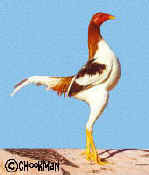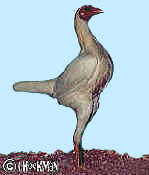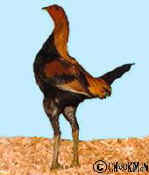The Modern Game was developed as a
purely exhibition fowl after the demise of legalised cock-fighting in Britain.
During its developmental years, the Modern Game
caused great consternation among the fighting-cock fraternity who believed that their
style of fowl was being completely destroyed. What in fact was happening, was the
beginning of a completely new breed of fowl that bore little resemblance to the fowls held
so dear to the hearts of the fighting-cock purists and as such, should not have caused any
discontent among them.
The large varieties of Moderns were developed first
and by the very early 1900s had reached a stage of perfection not seen among other breeds
of fowls. However their reign as the top exhibition fowl was relatively short-lived as
greedy entrepreneurs virtually priced the best birds out of the reach of most people,
which left them in the hands of the very rich. The lack of new breeders thus caused,
resulted in the virtual extinction of this fine breed and by the late 1920s, they had
nearly disappeared. Today, large Modern Games are a rarity.
The bantam varieties fared much better than their
large cousins. As they had appeared even before the bantamised form of the traditional
fighting-cock, they held a much stronger position than had the large Moderns.
Today, the Modern bantam is still quite popular as a
show fowl, though not nearly so, as the Old English Game. However a good Modern Game is
always a show stopper when presented properly. To succeed at show, the Modern must be well
trained to present itself to the judge but as the Modern Game is a quiet bird, this is not
really a difficult task. Pile and Black Red are the most commonly seen varieties in
Australia, with Duckwings, Brown Reds, Birchens and some off-colours seen at various
shows. Unfortunately, the Brown Reds today, lack the correct lemon colouring, due to
numerous crosses with Black Reds to improve type. |

A magnificent Pile bantam cockerel

A Pile pullet

A Black Red cockerel
|